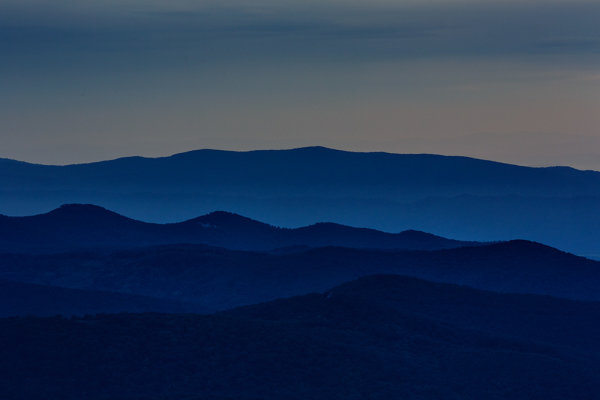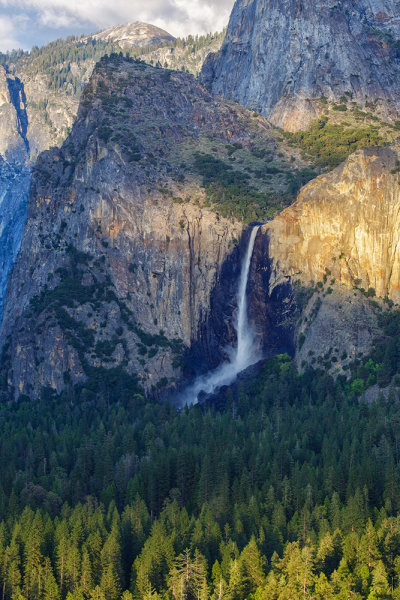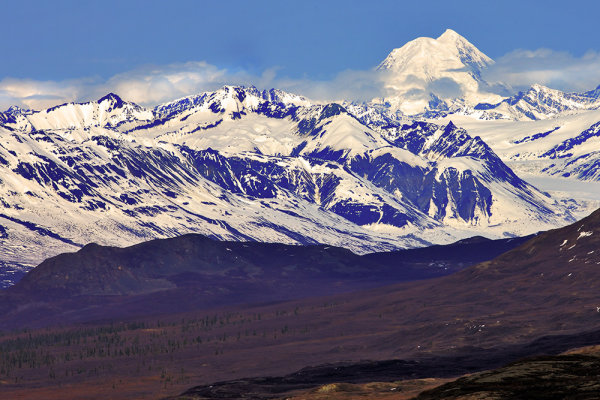
This shot of the Blue Ridge Mountains was taken with an EOS 5D Mark III and EF 70-200 f/2.8L IS II lens at 200mm. The telephoto nature of the lens compresses the distance between the ridges, creating a flat, graphic look with shades of blue created by the mountains and mist in the valleys. Exposure is 1/3″, f/16, ISO 400.

This shot of a lone pine on the side of a cliff was taken from Glacier Point at sunset. Using a 400mm lens allowed me isolate the tree being kissed by sunlight while the background behind went dark. I used an EOS 5D Mark II with EF 100-400mm L lens at 400mm. Exposure was 1/60 f/8, ISO 100.
If you’re anything like me, when presented with a beautiful landscape, your first instinct is to reach for the wide angle lenses and take it all in. And there’s no doubt about it- wide angle lenses can excel in those situations. But don’t neglect the telephoto lenses in your bag when you find yourself faced with nature’s beauty. Telephoto lenses can create shots that are every bit as breathtaking as their wide angled brethren.
Telephoto lenses, first and foremost, can allow you to isolate an area of the view you are shooting, because a telephoto sees a narrower angle of view than do wide angle lenses. Because of this narrower angle of view, telephotos also help normalize the size of near objects in relation to faraway objects. With wide angle lenses, when you fill the frame with a near object, it will appear much larger than a similar sized object placed further away. With telephoto lenses, near objects and far objects will appear to be similar in size, because telephoto lenses normalize the size and distance when comparing the two objects. The downside to this is that the scene can then appear to be static and flat.There are cases where the flatness can be used to advantage, for instance creating graphic images using the lines and colors of the landscape.
Telephoto lenses appear to compress distance, so two objects relatively far apart will appear to be very near to each other. This is helpful when trying to enhance the density of a subject, such as a field of flowers. Flowers will appear to be stacked right next to each other, even though they may be several feet apart. This can be used to great advantage for creative textures and patterns.
Often, when I’m trying to divide the space in my bag, a friend will ask why I need a telephoto lens when I’m planning to shoot landscapes. This is why. I may not use it every time, but when I do get an opportunity use a telephoto lens in a landscape situation, I like to be able to take advantage of it.

This shot, taken with an EOS 5D Mark III and EF 70-300 f/4-5.6L, shows how you can isolate one area of a landscape, here focusing on Bridal Veil Falls in Yosemite National Park.

This shot of the Alaska Range was taken from Denali Highway using an EOS-1Ds Mark III and EF 70-200 f/2.8L IS II. The telephoto lens compresses the distance between the foothills and the mountains, making them appear to be right next to each other.
Post originally from: Digital Photography Tips.
Check out our more Photography Tips at Photography Tips for Beginners, Portrait Photography Tips and Wedding Photography Tips.
Zooming In: Using Telephotos In Landscape Photography

Digital Photography School





You must be logged in to post a comment.